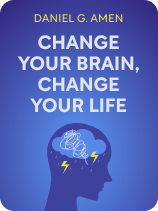

This article is an excerpt from the Shortform book guide to "Change Your Brain, Change Your Life" by Daniel G. Amen. Shortform has the world's best summaries and analyses of books you should be reading.
Like this article? Sign up for a free trial here.
Do you experience unwarranted or excessive nervousness? Do you bite your nails or have other compulsive habits?
Psychiatrist and brain health expert Daniel G. Amen argues that basal ganglia dysfunction might be to blame if you’re nervous or worried much of the time. He discusses the symptoms and shares several treatments that could calm your nerves.
Keep reading to learn how to stop feeling nervous by addressing basal ganglia dysfunction.
Feeling Nervous
If you constantly feel anxious and nervous, predicting the worst in every situation, your basal ganglia might be damaged. These signs align with specific issues Amen details, including:
- Emotional and psychological issues—heightened anxiety, muscle tension, easily triggered startle responses, reduced confidence, excessive fear of judgment, sensitivity to criticism, a tendency to freeze and avoid conflict, and compulsive habits like nail-biting
- Cognitive and fine motor impairments—memory lapses, concentration difficulties, tics, and fine motor skill issues, such as poor handwriting
We’ll look at some other potential causes of these symptoms and then turn to Dr. Amen’s advice for how to stop feeling nervous by treating basal ganglia dysfunction.
| Alternative Factors That May Influence These Symptoms While the symptoms mentioned can indicate basal ganglia dysfunction, health experts suggest various other factors that might cause them. Investigating these factors may help ensure accurate diagnoses and treatments. Heightened anxiety might stem from substance abuse or withdrawal, panic disorders, or specific phobias, such as agoraphobia or claustrophobia. Muscle tension can arise from heightened stress, or from conditions like fibromyalgia or repetitive strain injury. Easily triggered startle responses might be linked to post-traumatic stress disorder (PTSD), excessive caffeine, or sensory processing disorders. Reduced confidence, fear of judgment, and sensitivity to criticism can arise from a social anxiety disorder, avoidant personality disorder, or a heightened negativity bias. Memory lapses and concentration difficulties can result from attention deficit hyperactivity disorder (ADHD), age-related cognitive decline, or vitamin deficiencies. Tics and fine motor skill issues might be due to reactions from certain drugs, or from conditions such as Tourette syndrome or obsessive-compulsive disorder (OCD). |
Repair and Optimize Your Basal Ganglia
Amen’s recommendations for repairing and optimizing your basal ganglia region include the following treatments and strategies:
Heart rate variability (HRV) training: Enhancing the beat-to-beat variation in heart rhythm, achieved through techniques like controlled breathing, helps increase the time interval between consecutive heartbeats. This lowers stress levels, improving the basal ganglia’s ability to maintain emotional stability and fine-tune physical movements.
(Shortform note: Bessel van der Kolk (The Body Keeps the Score) clarifies that poor HRV means your breathing and heart rate are out of sync. This negatively affects how you respond to stress and makes you vulnerable to issues such as heart disease, cancer, and depression. He says that one way to train yourself to change your breathing (and thus improve your HRV) is by practicing yoga.)
Deep diaphragmatic breathing: Taking slow, deep breaths (inhaling for five seconds, holding in for two, exhaling for five, and holding out for two) improves oxygenation and removes waste products from your brain, enhancing basal ganglia function.
(Shortform note: In addition to enhancing basal ganglia function, deep breathing positively impacts heart rate variability (HRV) and spontaneous baroreflex sensitivity, key indicators of the body’s stress response and ability to regulate blood pressure. Improvements in both these areas can improve cardiovascular function, resulting in lower blood pressure and a decreased risk of heart disease.)
Hand warming visualization: Imagining activities that warm your hands, such as sitting by a warm fire, physically increases hand temperature. This induces a relaxed state that lowers blood pressure, promoting optimal basal ganglia function.
(Shortform note: Some Buddhist monks use a similar technique to induce significant physiological changes to stay warm in the Himalayas. They practice a style of meditation known as “g-tummo,” which uses a combination of breathing techniques and intense visualizations—for example, contracting pelvic muscles while imagining a flame ascending from the base of the spine to the top of the head. This practice effectively increases their core body temperature, often reaching levels comparable to a mild fever.)
Eye movement desensitization and reprocessing (EMDR): Guiding eye movements to process traumatic memories and reduce their emotional impact helps the basal ganglia maintain emotional balance. This treatment typically requires a trained professional to lead you through the process.
(Shortform note: Van der Kolk (The Body Keeps the Score) suggests that EMDR promotes emotional balance by helping patients diminish the impact of traumatic memories by linking them to other, loosely related thoughts and memories. This process recontextualizes traumatic events as “just another” memory—something that’s in the past, that doesn’t have power over them in the present.)

———End of Preview———
Like what you just read? Read the rest of the world's best book summary and analysis of Daniel G. Amen's "Change Your Brain, Change Your Life" at Shortform.
Here's what you'll find in our full Change Your Brain, Change Your Life summary:
- A more effective approach to overcoming physical, mental, and cognitive issues
- The four factors to nurture to improve your brain health
- Why listening to Mozart can enhance your focus and mood control






